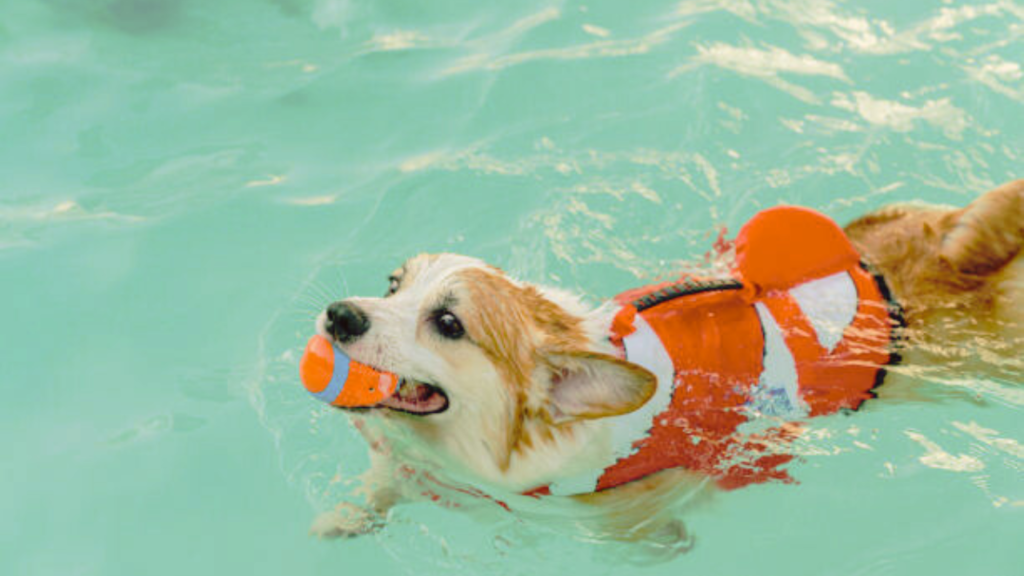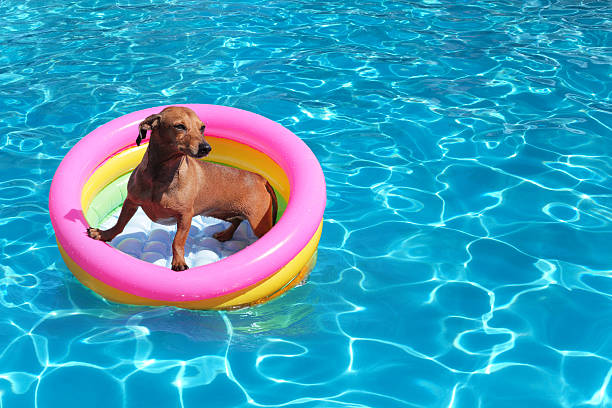Dog-Swimming-Pool-Benefits-Training-Safety-Maintenance

Dog-Swimming-Pool-Benefits-Training-Safety-Maintenance
Meta Description: Discover the benefits of dog swimming pools for canine fitness, hydrotherapy, and training. Learn how to maintain your dog pool, ensure safety, and find pet-friendly pool options.
Dog Swimming Pools: A Guide to Canine Hydrotherapy, Fitness, and Fun
Dog swimming pools have become a popular trend among pet owners looking for ways to boost their dogs’ health and provide them with hours of fun. If you’re considering adding a dog pool to your backyard or are simply curious about canine hydrotherapy, you’re in the right place. In this article, we’ll explore everything you need to know about dog pools, from exercise benefits to maintenance and safety tips.

1. Introduction to Dog Swimming Pools
The idea of dog swimming pools has evolved significantly over the years. No longer just a luxury for show dogs, these pet-friendly pools are becoming a go-to solution for dog owners seeking to improve their dogs’ fitness, provide rehabilitation therapy, or simply allow their pups to cool off during hot summer months.
The rise in popularity of dog swimming pools can be attributed to the growing awareness of the health benefits they offer. Whether you’re looking for a dog hydrotherapy session or just a place for your dog to play and exercise, a pet-friendly pool can be a game-changer.
2. Benefits of Dog Hydrotherapy
What is Dog Hydrotherapy?
Dog hydrotherapy, also known as canine water therapy, involves using water to aid in the rehabilitation and fitness of dogs. This therapy is particularly useful for dogs recovering from surgery, injury, or chronic pain conditions like arthritis. The buoyancy of water reduces stress on the joints while allowing dogs to build muscle strength and mobility.
Role in Rehabilitation and Fitness
Water therapy is a gentle yet effective form of rehabilitation. For senior dogs, it can ease pain while helping them regain strength and mobility. Hydrotherapy can also enhance a dog’s cardiovascular health and improve overall muscle tone.
3. Canine Swimming: A Fun and Effective Exercise
Swimming is one of the most effective full-body workouts for dogs. The resistance of water makes it an excellent exercise option for dogs of all ages and fitness levels. It’s especially beneficial for dogs with joint issues or those who are overweight. Swimming promotes cardiovascular health, improves endurance, and helps tone muscles without putting excessive strain on bones and joints.
Ideal Swimming Pools for Dogs
When choosing a pool for your dog, it’s important to look for a pool designed specifically for canine use. These pools often have gently sloping entryways, non-slip surfaces, and are designed to accommodate dogs of all sizes. If you’re building a pool, you should ensure it’s deep enough for swimming but shallow enough to keep your dog safe.
4. Dog Exercise Pools: Tailored for Active Pups
A dog exercise pool is different from a regular pool. These pools are specifically designed to give active dogs the opportunity to exercise safely in water. Some pools have resistance jets that provide additional challenges for the dog, helping to increase stamina and muscle strength.
Design Features of Dog Exercise Pools
Dog exercise pools are typically equipped with features that make it easier for your pup to swim and exercise. Look for pools that include:
Low entry steps
Adjustable water jets for resistance
Safety barriers
Non-slip surfaces to prevent accidents
5. Puppy Water Therapy: Starting Young
Introducing your puppy to water early on can help develop their confidence and comfort in the water. Puppy water therapy can be a gentle introduction to swimming, ensuring that your dog grows up with strong swimming skills and a love for water.
Benefits for Young Dogs
Water therapy can help improve balance, coordination, and muscle development. Additionally, it’s a great way to socialize your puppy and teach them the basics of water safety. Early exposure to swimming can also prevent fear or anxiety around water as they grow older.
6. Swim Training for Dogs: Techniques and Tips
Teaching your dog how to swim is not always an instant success. For some dogs, entering the water can be a frightening experience, especially if they are unfamiliar with it. The key to success in swim training for dogs is patience, consistency, and encouragement.

Overcoming Water Fear
Start slow by introducing your dog to the water gradually. Use a calm, shallow area where they can stand, and allow them to get used to the sensation of water on their fur. Praise them for their bravery and progress. Slowly, encourage them to swim in deeper sections while offering positive reinforcement.
7. Dog Pool Safety: Keeping Your Pup Safe in the Water
While swimming pools offer numerous benefits, they also come with certain risks. Dog pool safety should be a priority for every dog owner. Ensuring your dog is safe while swimming can prevent accidents and health issues.
Essential Safety Tips for Dog Pools
Make sure to keep a close watch on your dog while they are in the pool.
Ensure that the pool’s water temperature is comfortable (between 70-80°F is ideal for most dogs).
Invest in pool covers or fences to prevent accidental falls.
Ensure your dog has an easy exit point, like steps or a ramp, to climb out safely.
8. Canine Water Fitness: Improving Strength and Endurance
Swimming offers great benefits for canine water fitness, improving muscle tone, joint mobility, and overall endurance. For dogs who are aging, overweight, or recovering from injury, water-based fitness routines can help them regain strength and maintain a healthy body condition.
Creating a Fitness Regimen
When using swimming for fitness, create a routine that’s tailored to your dog’s abilities.Begin with brief sessions and slowly extend the time as your dog’s endurance builds up.
You can also incorporate water-based activities like fetch or tug-of-war to keep the sessions fun and engaging.
9. Dog Pool Maintenance: Keeping It Clean and Safe
Maintaining a dog swimming pool is crucial for ensuring your dog’s safety and health. A dirty pool can lead to infections or skin issues, while poor maintenance can result in accidents. Proper maintenance helps ensure a safe and enjoyable swimming experience for your dog.
Best Practices for Pool Maintenance
Clean the pool regularly, removing debris and ensuring the water is free from bacteria and algae.
Test the pool’s pH level regularly to make sure it’s safe for your dog to swim.
Ensure the pool’s filtration system is working efficiently to maintain clean water.
10. Dog Spa Services: Pampering Your Pooch
For those who want to take their dog’s pool experience to the next level, dog spas that offer dog spa services are a fantastic option. These services often include swimming, massage therapy, and even grooming, providing an all-around wellness experience for your dog.
How Dog Spas Contribute to Your Dog’s Well-Being
Dog spas offer tailored care that goes beyond swimming. Many dog spas provide additional therapies, such as hydrotherapy, muscle relaxation treatments, and special pampering services. These services can help your dog feel rejuvenated and pampered while promoting overall health and relaxation.
Conclusion: Why Your Dog Needs a Swimming Pool
In conclusion, investing in a dog swimming pool offers a multitude of benefits for your dog’s physical and mental well-being. Whether you’re using it for fitness, therapy, or fun, swimming is an excellent way to engage your pup in low-impact, enjoyable exercise. Be sure to prioritize safety and maintenance to keep the experience positive for both you and your dog.
FAQs
1. Can all dogs swim?
Not all dogs are natural swimmers, but most dogs can learn with proper training and encouragement. Certain dog breeds are naturally more adept at swimming than others.
2. How often should I let my dog swim?
It depends on your dog’s age, breed, and health, but generally, swimming a few times a week is ideal for most dogs.
3. Is it safe to let my dog swim alone?
No, you should always supervise your dog while they swim to prevent accidents or injuries.
4. How do I maintain my dog’s swimming pool?
Regular cleaning, checking water levels, and using a proper filtration system are essential to maintain a safe and clean pool.
5. Are dog pools only for exercise?
No, dog pools are also great for therapy, recreation, and even relaxation. Some spas offer additional services to make the experience more enjoyable.



